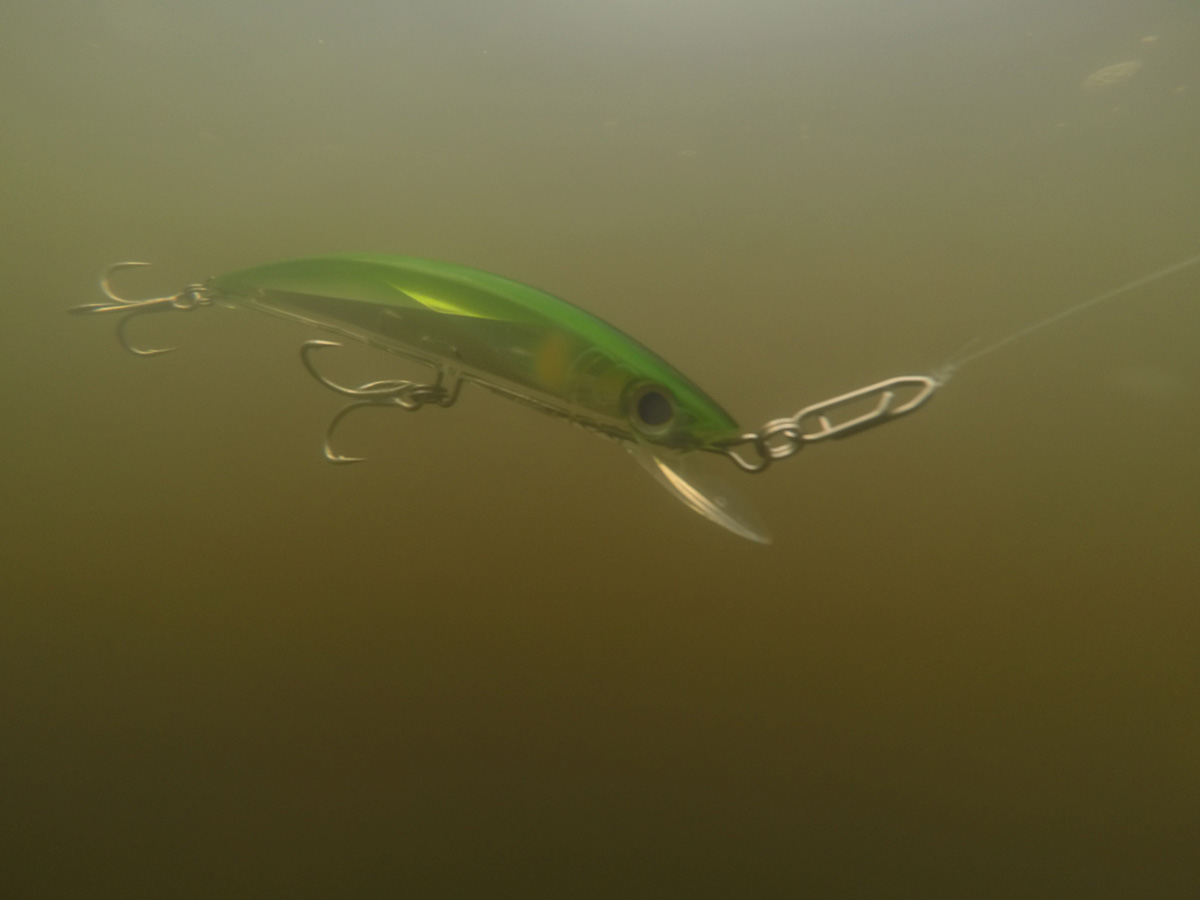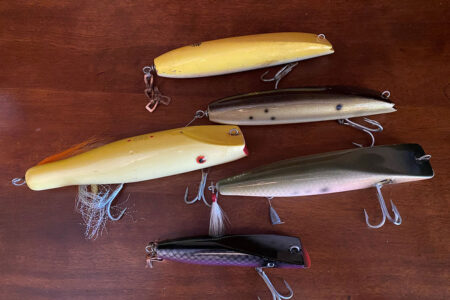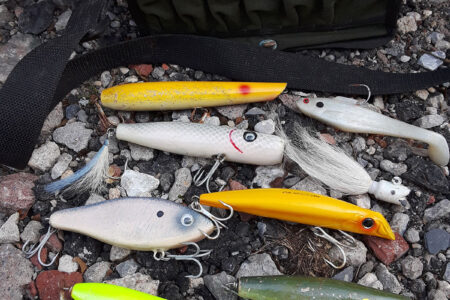
There are probably 50 or more 5- to 9-inch plastic-lipped-swimming plugs available today that can be purchased for anywhere from $5 to maybe $15 and are downright killers in the surf for striped bass, bluefish, weakfish and most any other species that regularly inhabit the littoral zone. They mimic a wide variety of baitfish, and over the years they have duped striped bass as large as 60-plus pounds in the surf.
For the purpose of this article, and because it’s what I find myself calling all of these lures, I will simply refer to them as “Finnish swimmers.” This naming convention hails back to my younger days reading the library of books and articles written by Frank Daignault. He generally classified all of the thin-bodied lures with a small protruding plastic lip under this name, giving credit to the original Rapala, which hailed from Finland; hence the name, Finnish swimmer. For me this name is easily recognizable and specific. I have seen them referred to as swimmers, plastic swimmers, skinny plastic swimmers, minnow baits, stick baits, crankbaits, plastics and a bunch of other variations, but I’ll stick with the one.
The Classics
As noted above, Rapala kind of got this lure style started in the United States thanks to its initial import in the late 1950s. Originally targeting the freshwater crowd, some years later the lures saw their inevitable use in the salt and the craze was off and running. In a short amount of time several other lures hit the market after Rapala including (in no particular order) the Cotton Cordell Red Fin, the Whopper Stopper Hellcat (no longer produced), the Rebel Minnow, the Bomber Long-A and the Nils Master Invincible. Within these primary lures quite often there were different sizes and variations by the manufacturer. For example, the Rebel Minnow was available as a floater, sinker, super minnow, wind cheater, jointed, and in different lengths, which were all, for the most part, simple-yet-specific variations of the one general body style.
Now I am sure that there were a few others that I left off this list, but these were the primary lures that stuck around for at least a few years leading up to about the early ‘90s, give or take a few years.
Modern Movers
Wow, where to begin here? Where the classic forms of the Finnish swimmer includes around a half-dozen lures, today you might find a single manufacturer alone producing more than twice that number of truly different lures that could fall under the same umbrella. Right off the top of my head we’ve got multiple Finnish swimmers currently produced by each of the following companies: Yo-Zuri, Rapala, Cotton Cordell, Bomber, Sebile, Williamson, Daiwa, Shimano, Savage Gear, Storm and more.
While with a greater selection of options one might not always find a better product, I will say that there are some notable improvements in many of today’s Finnish swimmers. Quite a few of these new takes on the old classics include such features as through-wiring, bullet-proof photo-realistic finishes, holographic and color-changing patterns, stronger swimming lips and so-on. This is one class of lures where quite often newer is in fact better and manufacturers continue to improve on the lures through competition with each other, and the consumer reaps the benefits in the end.
Reasonable Facsimiles
A Finnish swimmer, when matched to the length and color of a slender bait like a sand eel for instance, is a killer when that is what bass are heavily feeding upon. But what about when they have a school of adult bunker, snapper blues or juvenile weakfish in the wash? The Finnish swimmer is also a great lure in this scenario. I try not to get too caught up in ever-so-perfectly matching a baitfish profile when selecting a lure. While profile is extremely important to me, matching the length of a plug within reason seems to be more effective than throwing a slender lure when slender baits are present or a tall-bodied lure when such bait is on the menu.
An example of what I mean here is the history of both large needlefish and darters producing extremely well for me when schools of adult bunker run the beaches despite neither one having the exact shape of said baitfish. So long as my lures have the same length and general swim of the baitfish that is present, I find success. The same can be said of Finnish swimmers as I have done extremely well on more than a few times when the baitfish of choice was of the same length but a different body shape.

Make ‘Em Your Own
I am a strong proponent of tweaking lures to fit my specific needs as I have very few lures that are 100 percent ready right out of the box. First off I remove the hooks and split rings and replace them with heavy duty versions of both. For some lures I opt for single in-line hooks, others receive different size treble hooks on each hanger, and others still receive only belly trebles and a flag (bucktail-dressed hook cut off at the bend to eliminate the “hook” altogether) in place of the tail hook. I also have specific rigging configurations for different locations and applications that work for me.
Once the hooks are all set, next up on the modifying list is loading. To load a plug involves drilling a small hole through the plug’s body and adding a desired amount of liquid or shot (steel or lead) to alter both the casting as well as swimming characteristics of the lure. The specifics here, much like hook rigging, is a very personal topic. What works best for me how and where I fish is likely different for another angler who fishes a different location. There is no one magic formula, and working out the kinks is all part of the fun of surf fishing.
Colorful Choices
Since most Finnish swimmers on the market today are made of some sort of plastic material, the colors available are almost limitless. Also take into account the fact that they are easily painted with one of the “fusion” spray paints designed to adhere to plastic and the sky is the limit in the color combinations you can throw. But is this all necessary?
Sure there are times when a certain color—for one reason or another—simply out-produces all other colors combined, but this is not generally the norm. Anyone who has followed my writing for even a short amount of time will know that I try not to get all caught up in fancy paint patterns or carrying myriad plug colors, and this theme holds true for Finnish swimmers. I stick to the basics of white, yellow and black, but I also throw in another color that has proven successful for me over the years on the Red Fin: chrome.

Before I learned any better, I assumed chrome plugs were little more than bluefish magnets. Then I came into a large supply of 7-inch chrome Red Fins with both black and blue backs. Having a large supply of this color, I began fishing them more and more and I found that they consistently produced striped bass, and some really big ones at that! What was even better was that they produced equally well regardless of the moon phase or brightness of the night and therefore whittled down the number of plugs I might otherwise need to carry on certain nights. I have tried other types of Finnish swimmers in chrome and have found similar success.
Now don’t get me wrong, Finnish swimmers are not magic lures by any means, but they are tools I generally do not forego when packing my surf bag for a night. If you haven’t tried them yet, why not add a couple to your surf bag this year and give them a real shot? I’m almost certain that you’ll be pleasantly surprised!



